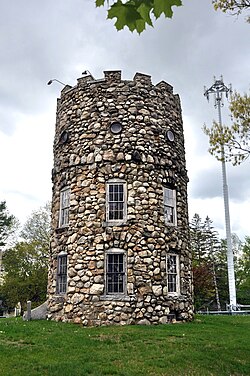
Fort William and Mary was a colonial fortification in Britain's worldwide system of defenses, defended by soldiers of the Province of New Hampshire who reported directly to the royal governor. The fort, originally known as "The Castle," was situated on the island of New Castle, New Hampshire, at the mouth of the Piscataqua River estuary. It was renamed Fort William and Mary circa 1692, after the accession of the monarchs William III and Mary II to the British throne. It was captured by Patriot forces, recaptured, and later abandoned by the British in the Revolutionary War. The fort was renamed Fort Constitution in 1808 following rebuilding. The fort was further rebuilt and expanded through 1899 and served actively through World War II.

Frederick Smyth was an American banker, railroad executive, and politician from Manchester, New Hampshire. Born in 1819 in Candia, New Hampshire, he became City Clerk of Manchester at the age of 30. A Republican, he served four terms as mayor of Manchester from 1852 to 1854 and again in 1864, and was the 30th governor of New Hampshire.

The Valley Cemetery is a public cemetery located in Manchester, New Hampshire, United States. It is bounded on the east by Pine Street, on the north by Auburn Street, on the west by Willow Street, and on the south by Valley Street, from which it derives its name. It was listed on the U.S. National Register of Historic Places in 2004, and the New Hampshire State Register of Historic Places in 2003.

Herron Gymnasium was a gymnasium and classroom building on the Miami University campus in Oxford, Ohio. Later known as Van Voorhis Hall, it was listed in the National Register of Historic Places in November 1979. Originally conceived in 1893, it was constructed in 1897 and named for John W. Herron, a Miami alumnus and Cincinnati judge. It was Miami University's first gymnasium, and would serve as the main recreational center until the construction of Withrow Court in 1932, which led Herron to become a women's gym. Except for an interlude during World War II when it served as a Navy barracks, it served as a women's gym until the construction of "New Herron" in 1962. In the late 20th century its use diminished to AFROTC and men's intramural sports, and the gymnasium was demolished in 1986 and replaced with a parking lot.
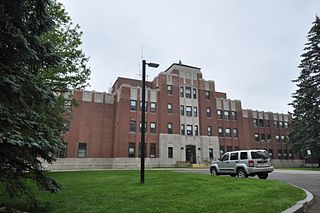
Togus, formally known as the Togus VA Medical Center, is a facility operated by the United States Department of Veterans Affairs in Chelsea, Maine. The facility was built as a resort hotel, and housed Union veterans of the American Civil War prior to being converted to a veterans hospital. It was the first veterans facility developed by the United States government.

The Lothrop Memorial Building-G.A.R. Hall is an historic building located at 95 Washington Street in Taunton, Massachusetts. It was originally built in 1888 as the First Presbyterian Church, on land purchased from Marcus Morton, and now houses professional offices. It was for many years home to the William H. Bartlett GAR Post No. 3 of the Grand Army of the Republic, a veterans organization, which ran the building as a community center. It was added to the National Register of Historic Places in 1984.

The Beth Eden Baptist Church is a historic Baptist church building at 82 Maple Street in Waltham, Massachusetts. Built in 1891, it is a fine local example of Romanesque Revival architecture, and is further notable as the oldest church on Waltham's South Side. The church was added to the National Historic Register of Historic Places in 1989. Its current minister is Rev. Dr. Sylvia Torrence Johnson.

The Weston Observatory is a historic folly on Oak Hill, the high point of Derryfield Park in Manchester, New Hampshire. Built in 1897, the granite tower is a prominent local landmark, given to the city by James A. Weston, a Manchester native who served twice as governor of New Hampshire. The tower was listed on the National Register of Historic Places in 1975.
Church of St. Dismas, the Good Thief is a historic Roman Catholic church at the Clinton Correctional Facility on Cook Street in Dannemora, New York.

Garrison Hill Tower is a 76-foot-tall (23 m) observatory atop Garrison Hill in Dover, New Hampshire, United States. The current tower, made of iron and painted green, was built in 1993 and is the third tower to exist on the hill. The park in which it stands is listed on the National Register of Historic Places.

Veterans Affairs Medical Center is a 160-bed, acute care medical facility opened in 1929 by the Oregon Department of Veterans' Affairs, located on Marquam Hill in Portland, adjacent to Oregon Health & Sciences University, and is connected to Oregon Health & Science University Hospital via a skybridge. The original hospital was replaced in the 1980s and had a capacity of up-to 478 beds.
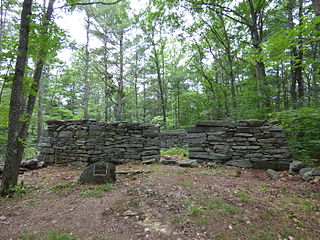
The Farmington Town Pound is an historic animal pound in Farmington, New Hampshire. It is located on the north side of Pound Road near its intersection with Ten Rod Road. Built in 1823, it is one of the best-preserved 19th-century pounds in southeastern New Hampshire, and is now maintained by the Farmington Historical Society. It was listed on the National Register of Historic Places in 1993.
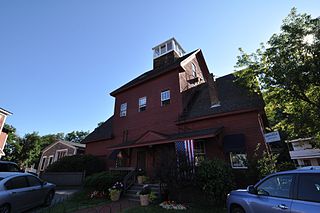
The Ashland Gristmill and Dam are a historic former industrial facility in the heart of Ashland, New Hampshire. Built in 1903 on the site of an older mill, the gristmill demonstrates the continuing viability of wood framing for mill buildings in an era when it had become uncommon. The property was listed on the National Register of Historic Places in 1979. It has been converted to professional offices.

Fasnacloich is a historic country estate in Harrisville, New Hampshire. Built in 1911 and expanded in 1916–17, the estate is one of the most sophisticated and elaborate summer estates built in the Harrisville-Dublin area during its heyday as a summer resort area. The estate is located off MacVeagh Road, south of its junction with Mason Road. Its builders were Charles MacVeagh and Fanny Davenport Rogers MacVeagh. He is notable for being United States Ambassador to Japan, and they were the parents of diplomat Lincoln MacVeagh. The estate was listed on the National Register of Historic Places in 1988.
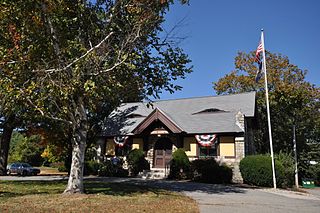
The Old North Hampton Library is a historic library building at 237 Atlantic Avenue in North Hampton, New Hampshire. The small, single-story Tudor Revival structure was designed by Boston architect J. Lawrence Berry and built in 1907. It was the town's first purpose-built library building, and was used as such until a new library was built nearby in 1973. It presently houses town offices. The building was listed on the National Register of Historic Places in 2014, and the New Hampshire State Register of Historic Places in 2013.

Smyth Public Library refers to several buildings that have served as the public library of Candia, New Hampshire, United States. The current building, which opened in 2002, is located at 55 High Street. The previous library building at 194 High Street was constructed in 1932 and was listed on the National Register of Historic Places in September 2007, and the New Hampshire State Register of Historic Places in April 2007.
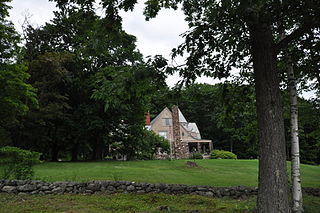
Wildwood Hall is a historic house on Moore's Hill Road in Newbury, Vermont. Also known locally as The Castle, it is a distinctive example of Shingle style architecture, designed as a country house by William M. Butterfield and completed in 1895. It was listed on the National Register of Historic Places in 1978.

The Manchester VA Medical Center is a medical facility for US military veterans located in Manchester, New Hampshire. It is part of the VA New England Healthcare System, and operates under the Department of Veterans Affairs to provide healthcare to veterans who are residents of New Hampshire. Built in 1950, it is the only Veteran's Affairs medical facility in the state, but is no longer a full-service hospital.
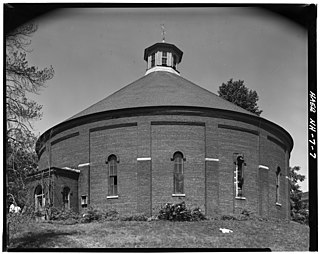
The Concord Gas Light Company Gasholder House is a historic gasholder house at Gas Street in Concord, New Hampshire. Built in 1888, it is believed to be the only such structure in the United States in which the enclosed gas containment unit is essentially intact. It was listed on the National Register of Historic Places in 2018. Since 2012, it has been owned by Liberty Utilities, a gas, water and electric company. In 2022, Liberty struck a deal with the city of Concord and the New Hampshire Preservation Alliance to begin emergency stabilization work on the building, so that planning for protection and future use can continue.
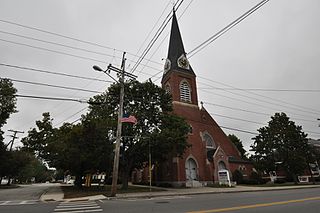
The First Congregational Church is a historic church at 400 Main Street in Farmington, New Hampshire. Built in 1875 for a congregation founded in 1819, it is the oldest church building in the town, and a distinctive example of Gothic Revival architecture designed by New Hampshire native Frederick N. Footman. The church was added to the National Register of Historic Places in 2018, and the New Hampshire State Register of Historic Places in 2017. The congregation is affiliated with the United Church of Christ.
